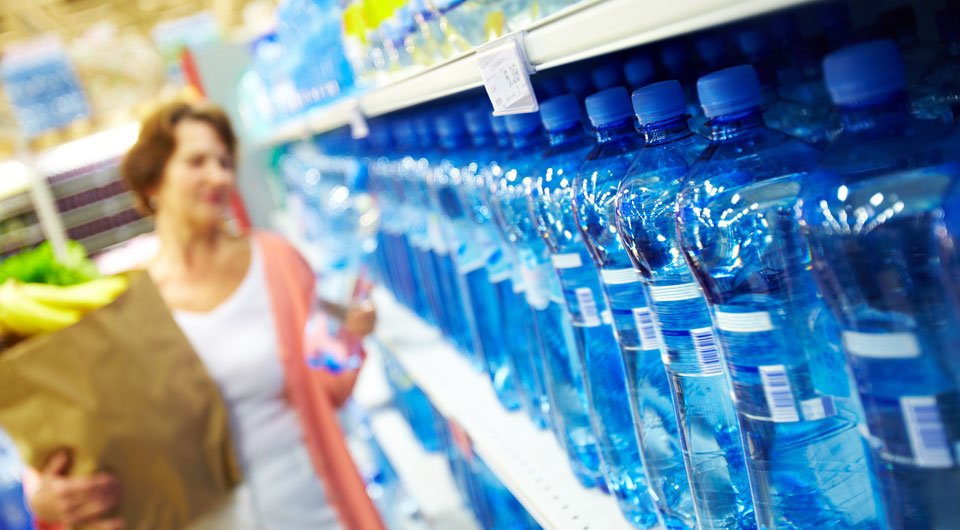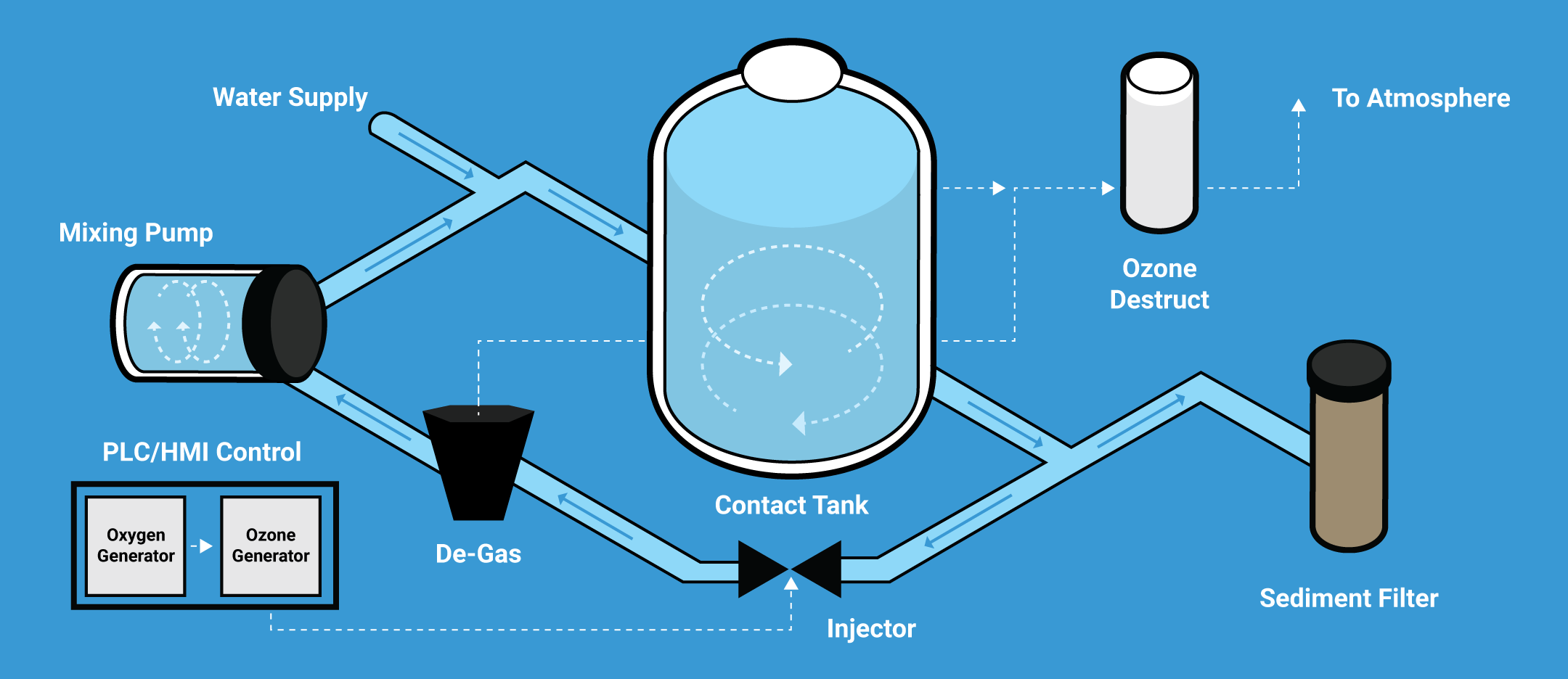
Bottled Water Industry and Ozone Treatment
Ozone is a sustainable and environmentally safe treatment for water that is chemical-free, energy-efficient and cost-effective.
For the bottled water processing sector, Aclarus Ozone provides water treatment solutions for the following operational challenges:
Source water for the final bottled product
Process water and Clean-in-Place (CIP) sanitation
Wastewater and Re-use
Ozone Advantages for the Bottled Water Industry
As we all know the availability of safe, clean bottled water is vitally important for survival. For example, many remote communities around the world do not have reliable water treatment systems and must rely on bottled water for their household needs. Largescale emergency events – such as catastrophic storms or military conflicts – can also create an immediate need for potable water. In cases like these, bottled water fulfills a critical function.
Ozone treatment is the most frequently used disinfection process in water bottling today. It is the universal preferred treatment for bottled water – both for the source water and the sanitation of the bottles themselves – because it has numerous advantages over traditional disinfection methods. Supplementing or replacing an existing system with an ozone system has the potential to boost a company’s advantage over its competitors.
Ozone has the following advantages for bottled water processing operations:
✓ It is chemical-free; and breaks down to oxygen after treatment;
✓ Treats incoming source water to produce premium quality water;
✓ Neutralizes unhealthy minerals like iron, sulphur and manganese;
✓ Removes any colour, taste or odour;
✓ Removes contaminants of emerging concern (CEC’s), such as pesticides, organic matter, various microbes, pharmaceuticals and micro-plastics;
✓ Compliant with Canadian Food Inspection Agency (CFIA) and the U.S. Food and Drug Administration (FDA) for water and surface sanitization.
✓ Disinfects and sanitizes equipment and surfaces quickly, without chemicals;
✓ Enables greater water conservation and re-use of wastewater, and;
✓ Produced onsite, removing the need to purchase, store and physically handle chemicals;
Ozone Water Treatment
Is chemical-free and a sustainable solution;
Is fully automated with remote access, for ease of use and integration;
Completely disinfects and removes contaminants, including colour, for assured re-use quality;
Reduces or eliminates fees on discharge and incoming water;
Has low life-cycle costs with a quick ROI.
Aclarus Water Treatment Solutions
Bottled Drinking Water
Ozone can be used “on demand” to treat incoming water to produce premium quality drinking water that is fully disinfected without the use chemicals. It has no impact on pH levels in the water and leaves no residual, as it breaks down to oxygen before use.
Ozone solves multiple water treatment issues safely and efficiently. Regardless of the source of the water, ozone and post-filtration will quickly remove:
Pathogens
Bacteria (E. coli, Streptococcus, Cholera, Pseudomonas, Mycobacterium)Virus (Adenovirus, Legionella, Rotavirus, Salmonella, influenza, hepatitis, polio)
Cysts; (Giardia, Crypto, Cyclospora, E. Dispar)
Contaminants:
Metals - (Iron, Manganese, Sulphur, Lead, Arsenic)Organics - (Biofilm, Algae, Tannin, Colour, NOM)
Inorganics - (Cyanides, COD)
Chemicals – (Chlorine, sulphur dioxide, and chlorine-containing organic by-products (e.g. trihalomethanes)
*Contaminants of Emerging Concern (CECs):
Pharmaceuticals & Personal Care Products
Hormones, Antibiotics, Medications
Estrogen, Sulfamet, Oxycodone, Ibuprofen, Triclosan
Amphetamines, Cocaine, Opioids
PFAS (per & Polyfluoroalkyl Substances - Teflon)
Micropollutants & Microplastics
* A joint study by McGill University and Aclarus Ozone found that ozone removed 86% of CECs versus 7% for Ultraviolet (UV) treatment.
Process Water and Clean-In-Place (CIP) Sanitation
For the bottled water industry, it is critically important that the water used throughout the processing chain is fully disinfected and of premium quality – thereby preventing any possible contamination during the production process.
Ozone is compliant with Health Canada, the CFIA and the U.S. FDA for both process water and surface sanitization. It is gentler than many common chemicals currently used for sanitation, and it is commonly used for cleaning bottles as well as surfaces found in the production chain, such as equipment, walls, floors, and tables.
Following industry standard practices, ozone is applied as a final rinse sanitation to treat bacteria, viruses, fungi, and more. Only cold water is required, and no final rinse needed, as ozone leaves no residual. This saves time, water, and energy costs. If a bottled water processer uses soaps, detergents, pressurized water and a chemical like chlorine, these cleaning steps can require multiple rinses, often with hot water or steam, to remove residues. This process takes time, is labour intensive, raises energy costs (to heat the water), poses worker safety concerns, and can consume significant amounts of water.
To preserve the quality of water throughout the entire processing chain, ozone can be used in a Clean-in-Place (CIP) closed loop system that involves the cleaning and sanitizing all production equipment – including pipes, pump systems, tanks, hoses, filters and packaging lines.
Ozone CIP also benefits run-off water from the cleaning process because any residual ozone can reduce contaminants in the run-off water, helping to keep drain lines clear. Since only oxygenated water is produced, the run-off is safe for discharge without concerns for septic or municipal systems.
Ozone is carefully measured and monitored to a to remain in the plumbing system to protect against bacteria, biofilm and other contaminant. The ozonated water is continuously re-circulated through the piping systems, reacting with organic materials. Since it is gentler than many common chemicals currently used for CIP sanitation, ozone can significantly prolong the lifespan of the piping, cooling towers and other equipment.
Aclarus ozone generators have built-in controls that receive signals from ozone sensors connected to the pipes or tanks. This allows machinery to be cleaned and sanitized easily and automatically and reduces the amount of wastewater produced.
Wastewater and Re-Use
Wastewater produced during bottled water processing presents both cost and regulatory challenges to the industry.
Ozone safely treats wastewater, helping to keep drain lines clear and only producing oxygenated water that is safe to discharge without concerns for septic systems and municipal requirements. It is a cost-effective treatment that’s enables bottled water processers to achieve regulatory compliance and reduce fees and fines.
Moreover, ozone-treated wastewater in a CIP closed-loop system can be re-used for non-potable purposes. This results in cost savings and is an obvious environmental benefit at a time when freshwater shortages are occurring.
Ozone Aclarus engineers assess the wastewater needs for each processer and design a solution to fit the need through testing and/or pilot demonstrations. This is done to determine the level of treatment and ozone required (e.g. disinfection, biochemical oxygen demand (BOD), chemical oxygen demand (COD), total suspended solids (TSS), etc.).
By using ozone in the CIP sanitation process, the run-off water requirements are lessened, “reducing at least by 50% the organic load in the cleaning waste waters produced” (Canut et al2013). This is due to ozone’s ability to reduce COD and remove many contaminants prior to discharge.
Aclarus Ozone Systems Overview
Aclarus Ozone systems generate ozone on-site, with an ozone level calibrated for each application and flow rate. The systems are scalable to accommodate microbreweries to large-scale operations and they offer advanced ozone generation, mixing and control systems for reliable and accurate treatment.
Aclarus systems are easily retrofitted into existing facilities and are modular, to allow expansion when required. They can range from simple on/off systems to fully programmable control systems with remote monitoring, alarm integration, ozone dose control and more.
Aclarus’ advanced saturation systems maximize ozone transfer into water at an average of over 90% compared with traditional transfer rates of approximately 10%. Using inline monitors, the water is measured for automated control to either increase or decrease the ozone level to remain at a setpoint for optimal function.
Following ozonation, the water is filtered and then ozone is either removed for incoming use or remains in the water for use in sanitation. In many cases ozone can work in a closed loop CIP to greatly lessen water use and waste.
Aclarus Ozone systems also remove excess ozone from the water and destroy it, limiting potential off-gassing by using integrated air monitors for safe workspaces.
Cost Comparison
There is a common perception that ozone is an unaffordable approach to water treatment. In fact, the average operational cost of the Aclarus Ozone System is approximately 5-10 cents per 1,000 litres of treated water, offering the lowest Lifetime Operating Cost (LOC) compared to other technology and a quick Return on Investment.
Aclarus Ozone systems are found in a wide range of applications, including industrial and municipal operations, precisely because they are a cost-effective and reliable treatment. Aclarus advanced and affordable designs have brought ozone to multiple markets that have not previously used ozone.
References
L. Joseph Bollyky, Ph.D., P.E. Bollyky Associates, Inc. Stamford, CT, 2002
Benefits of Ozone Treatment for Bottled Water, International Ozone Association Proceedings, 2002.
Do you have an ozone related question?
Read past responses or submit your question for Adam Doran Aclarus Co-Founder!








